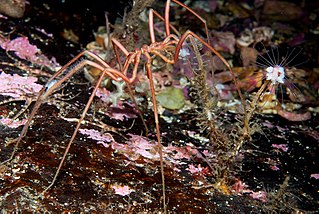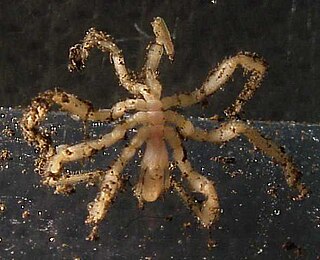
Sea spiders are marine arthropods of the order Pantopoda, belonging to the class Pycnogonida, hence they are also called pycnogonids. They are cosmopolitan, found in oceans around the world. The over 1,300 known species have leg spans ranging from 1 mm (0.04 in) to over 70 cm (2.3 ft). Most are toward the smaller end of this range in relatively shallow depths; however, they can grow to be quite large in Antarctic and deep waters.

Colossendeidae is a family of sea spiders. This family includes more than 100 species distributed among six genera. These sea spiders inhabit the deep sea mostly but are also found in shallower waters, especially in Antarctic and Arctic waters.

Nymphonidae is a family of sea spiders which has representatives in all the oceans. This family contains some 250 species, most of which are found in the genus Nymphon. Nymphonid bodies are between 1 and 15 mm long, the extent between the points of the legs reaching 150 mm. Most species are predators of hydroids. Like most sea spiders, species in this family have four pairs of legs, except for Pentanymphon antarcticum, which has five pairs, and Sexanymphon mirabilis, which has six pairs.

Nymphon is a genus of sea spiders in the family Nymphonidae. The species of sea spiders within the genus Nymphon are all benthic organisms and are found in abyssal and bathyal areas of the ocean. This is a fully marine group and can be found at various depths ranging from the littoral zones to the deep sea. They are found in most major oceans across the globe with a strong distribution around polar regions: Arctic and Antarctic waters. Out of the sea spider genus, Nymphon is the most rich, with a majority of the species within the genis being found in the Southern Ocean region. This genus may also contain bioluminescent species.

Pycnogonidae is a family of sea spiders.

Pycnogonum is a genus of sea spiders in the family Pycnogonidae. It is the type genus of the family.

Ammotheidae is the most diversified group of the class Pycnogonida, with 297 species described in more than 20 genera, of which only Nymphopsis and Sericosura were found to be monophyletic. Despite its internal taxonomic uncertainty, studies on 18S rRNA supports its monophyly, and the subdivision on Achelinae and Ammotheinae subfamilies.

Achelia is a genus of pycnogonids in the family Ammotheidae.

Tanystylum is a genus of pycnogonids in the family Ammotheidae.

Nymphon gracile is a species of sea spider first described by William Elford Leach in 1863. The species highly resembles other members of the genus Nymphon, and species identification from morphological traits alone is, therefore, a complex task.

Callipallene is a genus of sea spiders in the family Callipallenidae. There are more than 30 described species in Callipallene.

Sericosura is a genus of sea spiders in the family Ammotheidae. Species within this genus have been found living at depths from 106 to 3,690 meters below sea level.

Palaeoisopus is a monotypic genus of fossil pycnogonid, known only by one species, Palaeoisopus problematicus, discovered from the Lower Devonian Hunsrück Slate of Germany. It have several characters unusual for a pycnogonid, such as swimming legs with alternating size, medially-arranged eyes, and most significantly, a long, segmented abdomen, which were highly reduced in modern counterparts.
Colossendeis belekurovi is a species of sea spider belonging to the family Colossendeidae. The species was first described by Pushkin in 1993.

Colossendeis colossea is a species of sea spider in the family Colossendeidae. The species was first described by Edmund B. Wilson in 1881. It is the largest pycnogonid species known to science, reaching a leg span of 70 cm (28 in). Body length, including proboscis and abdomen, can reach 7 cm (2.8 in).
Colossendeis acuta is a sea spider that occurs in deep-sea habitats in the Antarctic Pacific. The species shows sexual dimorphism and the eggs are brooded by the male.
Dodecolopoda is a monotypic genus of sea spider in the family Colossendeidae. The only species in this genus is Dodecolopoda mawsoni. This species is notable as one of only two species of sea spider with six pairs of legs and the first such species to be discovered.

Decolopoda is a genus of sea spider belonging to the family Colossendeidae. This genus includes two valid species, D. australis and D. qasimi. As the name of this genus implies, these two species are among the seven species of sea spider with five pairs of legs instead of the usual four leg pairs. The species D. australis is notable as the first polymerous sea spider to be discovered.

Flagellopantopus is an extinct genus of pycnogonid arthropod known from the lower Devonian aged Hunsrück Slate. A single species is currently known, Flagellopantopus blocki, which was described from the Emsian aged Kaub Formation in Germany.














